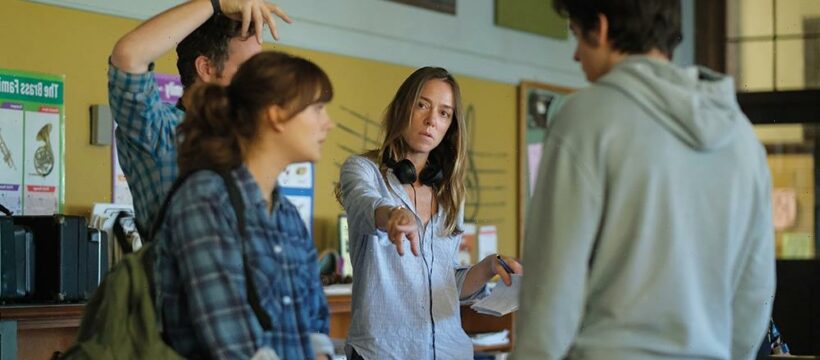“CODA” started as “a scrappy production with few resources and filmed in a short amount of time,” says writer-director Siân Heder. But it earned the audience favorite award at Sundance and has chalked up other honors recently, including the key best-acting-ensemble at the Feb. 27 SAG Awards. It is nominated for three Oscars: supporting actor Troy Kotsur, adapted screenplay and best picture. And if its underdog/Cinderella status continues, it could take all three on March 27.
Producers Philippe Rousselet and Patrick Wachsberger wanted an English-language remake of the French “La Famille Bélier.” Heder pitched the idea of setting it in a fishing family, with a more authentic depiction of deafness.
Heder then began “an immersive research phase,” which included learning ASL. “I felt ASL is a lynchpin to understanding deaf culture. I approached the script in the way I’d always approached writing. But I realized this ‘radio play in my head’ was absurd: It was going to be a completely visual experience. The relationship between English and ASL is very interesting; concepts and ideas are delivered completely differently in ASL.”
She went over her script, and choices about signing, line by line with ASL experts Anne Tomasetti and Alexandria Wailes. Things evolved again as actors brought their own ideas. “The script was a fluid, breathing thing; it was an amazing process.”
Daniel Durant, who plays the son in the Rossi family, tells Variety, “Siân was well prepared. In the first draft, from step one, she got so much right about deaf culture and deaf perspective.”
Durant first encountered Troy Kotsur when he was cast in L.A.’s Deaf West Theatre’s “Cyrano,” with Kotsur in the title role. “I was blown away. In ‘Cyrano,’ it was the same role with the same lines, but he would change every night. He carried that same energy into ‘CODA.’ For every line you see in the movie, Troy did 10 different ways. He’s a genius.”
Heder agrees. “I came to the auditions for ‘CODA’ being very naive about how much deaf talent is out there, particularly in theater, and they’ve never gotten a chance. Troy had worked for 30 years and never gave up, without knowing if this moment would come. There’s something so beautiful about that. This is an artist who loves his art. Troy was the secret of the deaf community for decades, but now the world can see him.”
Kotsur, Durant and Emilia Jones, who plays the hearing daughter, went out with local fishermen for two weeks. “Troy had a commitment beyond what your average actor would do,” says Heder. “At one point, he was mending nets with a needle and thread and I said, ‘There’s no scene where Frank is mending a net, you don’t have to learn that.’ He said, ‘Yes, but Frank would know how to do this, so I want to know how.’
In making the film, which is available on Apple+, Heder and d.p. Paula Huidobro created an unusual shooting style: “When you cut the actors’ hands out of frame, you’re cutting off the language.” That also meant fewer closeups. In addition, she and editor Geraud Brisson realized “because ASL is visual language, it dictates its own editing style,” such as whether to cut away from a character who’s speaking.
“As a filmmaker, it was an ego-less experience: I had to figure out how to let the story be what it needed to be, and I was trying to figure out how to support it, with camera, sound design, editing. We hopefully created a film where you don’t notice the filmmaking, where it’s not calling attention to it. It’s about letting the story lead the way.”
Durant says, “In past films, the deaf character is often pitiable. ‘CODA’ is different because deafness is so normal. This is a normal family, they just happen to be deaf.”
Heder adds, “I wanted to make a film that people enjoy watching. I didn’t set out to teach anyone. I think the humor allows people to enjoy it without feeling like they’re being asked to eat their spinach.”
Durant agrees, “This isn’t a moral-lesson movie. This movie has a heart that anybody can relate to.”
On making films about disabilities, Heder concludes, “I want world to know how we did this because I think it can be repeated. When people see it can be done, there is more openness there will be to finance these projects.”
Durant adds, “In the disability community, there are so many skilled actors waiting for jobs. That talent is just waiting for you. It’s starting to change. I personally want to say thanks to Hollywood for cracking the door open and I hope ‘CODA’ will open it all the way.”
Heder says there’s a barrier in filmmaking that can be overcome: “I think the hearing community is full of fear. There is fear about saying the wrong thing or reacting in the wrong way. With an interpreter, for example, a hearing person doesn’t know where to look. By the way, you always look at the deaf person.
“These things are new for some people. We created a set where ASL was dominant language a lot of the time. A lot of the crew learned ASL. A camera operator on the first day said ‘I don’t know how to tell Troy how to move over.’ By the end, everyone was comfortable. It was a beautiful thing to watch the crew and the town of Gloucester embrace deaf culture. One of the fishermen changed from ‘You want me to take two deaf guys and teach them how to fish?’ to telling me at the wrap, ‘The sequel to this movie should be called “FODA,” for Friends of Deaf Adults and it should be about us!’
“There was a powerful human experience on the set,” Heder sums up. “I think most people who worked on this movie went out with a sense of what’s possible and increased openness to this community.”
Source: Read Full Article
